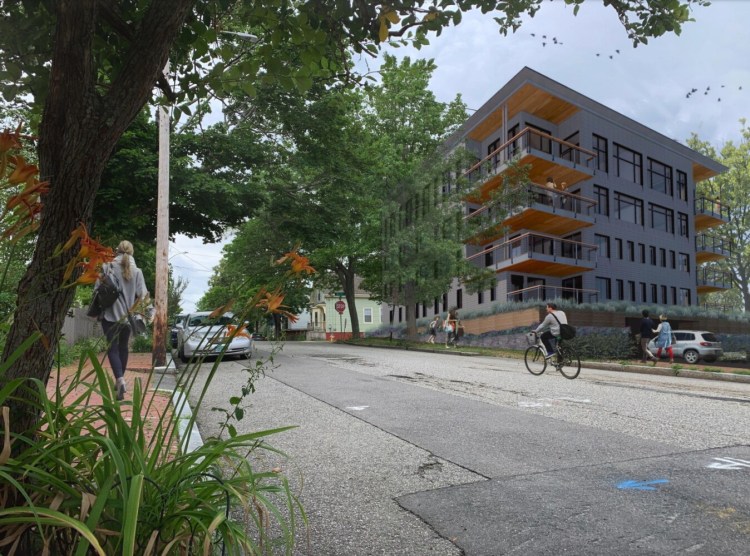The Portland Planning Board has given unanimous approval to a four-story, 12-unit condominium building in the Munjoy Hill neighborhood despite some neighbors’ concerns that the building is out of character and threatens the affordability of the area.
The proposed building at 19 Willis St. is among a handful of multi-unit housing projects to be approved in the Munjoy Hill conservation overlay district since the city approved its creation in 2018 in response to such concerns.
 “Overall, the board as a whole found it met the standards it needed to meet,” planning board Chairman Brandon Mazer said. “There were some questions about the historic district that were brought up. There were some questions about how grade and height were determined. Both those issues I think were addressed by staff to the satisfaction of the board as a whole.”
“Overall, the board as a whole found it met the standards it needed to meet,” planning board Chairman Brandon Mazer said. “There were some questions about the historic district that were brought up. There were some questions about how grade and height were determined. Both those issues I think were addressed by staff to the satisfaction of the board as a whole.”
The project, formerly known as 33-37 Montreal St., has highlighted the tension between some longtime residents in one of Portland’s most sought-after neighborhoods and the need to develop more housing in the city.
“Who are the winners and losers in this proposal? The winners are, of course, the developers who stand to gain additional wealth and an enhanced reputation in their community of developers,” Wayne Valzania, president of the Munjoy Hill Neighborhood Association, said in an email submitted to the board as public comment. “There will be an overlay of new residents who may or may not appreciate, or even understand, the essence of a small closely knit neighborhood. In either case, the population of the neighborhood will increase significantly.”
About half a dozen people weighed in during a public hearing before the board’s decision Tuesday in addition to those who submitted written input.
Maggy Wolf, who lives on Lawrence Street, is in favor of more affordable housing in Portland but said the Willis Street project will not be affordable. “If this were an affordable housing project, I certainly would not be objecting to it,” Wolf said. “But once again it’s to capitalize on the building boom for luxury housing on Munjoy Hill.”
Tim Wells, the project’s lead developer, disagreed with the concerns raised at the hearing.
“A four-story building is not out of character historically in this neighborhood,” Wells said. “It’s not an overly tall building. It’s still very human-scale. And not only that, but we need more four-story buildings in Portland so we’re not having urban sprawl and cutting down forests, building more roads, causing people to travel more and taking up farmland to build a bunch of single-family homes.”
The project, which consists of 12 condo units and underground parking, also includes one “workforce unit” that will be deed-restricted for affordability. It must still go through the permitting process, and Wells estimated it would be nine to 15 months before construction starts. While earlier plans called for demolition of the two vacant homes at 33 and 37 Montreal St., Wells said he now intends to try to preserve the homes and move them to a new location where they could be renovated and used as affordable housing.
“We’re trying to do that, and the city is working with us,” Wells said. “We’ll see if it’s possible.”
The conservation overlay district is aimed at making it more difficult to demolish some architecturally significant buildings. It adds requirements to better ensure new buildings are built in a style, size and scale that fits in with those that already exist.
While the Willis Street project was one of the first housing developments proposed following the creation of the overlay district, Christine Grimando, the city’s director of planning and urban development, said in an email Wednesday that a few others have since been approved, including ones at 130 Morning St.and 126 and 128R North St.
Wells said the rules for the overlay district are highly technical and onerous for developers and the city should revisit them in an effort to increase housing. He estimated the project’s location in the overlay district has added 15-20 percent to the cost of his project.
Mazer, the planning board chair, said it’s already in the board’s plans and could be discussed as early as next month. He said that when the board recommended approval of a smaller Munjoy Hill historic district last year, members indicated they wanted to look at whether the overlay would still be necessary. The City Council approved the Munjoy Hill Historic District, which is about half the size of the overlay, in April.
“Whether (the overlay) still works or is still needed now that we have a historic district (will be looked at),” Mazer said. “At least my personal opinion was the overlay district was meant to be sort of a temporary condition while the board and the council worked through the more lengthy historic preservation process.”
Send questions/comments to the editors.




Comments are no longer available on this story